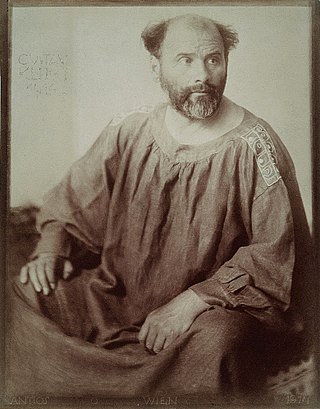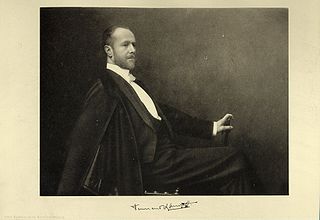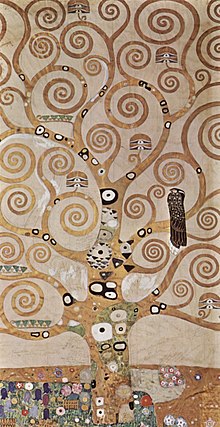
Gustav Klimt was an Austrian symbolist painter and one of the most prominent members of the Vienna Secession movement. Klimt is noted for his paintings, murals, sketches, and other objets d'art. Klimt's primary subject was the female body, and his works are marked by a frank eroticism. Amongst his figurative works, which include allegories and portraits, he painted landscapes. Among the artists of the Vienna Secession, Klimt was the most influenced by Japanese art and its methods.

Art Nouveau, Jugendstil in German, is an international style of art, architecture, and applied art, especially the decorative arts. It was often inspired by natural forms such as the sinuous curves of plants and flowers. Other characteristics of Art Nouveau were a sense of dynamism and movement, often given by asymmetry or whiplash lines, and the use of modern materials, particularly iron, glass, ceramics and later concrete, to create unusual forms and larger open spaces. It was popular between 1890 and 1910 during the Belle Époque period, and was a reaction against the academicism, eclecticism and historicism of 19th century architecture and decorative art.

Woluwe-Saint-Pierre or Sint-Pieters-Woluwe is one of the 19 municipalities of the Brussels-Capital Region, Belgium. Located in the eastern part of the region, it is bordered by Etterbeek, Auderghem and Woluwe-Saint-Lambert, as well as the Flemish municipalities of Kraainem and Tervuren. In common with all of Brussels' municipalities, it is legally bilingual (French–Dutch).

Fernand Edmond Jean Marie Khnopff was a Belgian symbolist painter.

The Wiener Werkstätte, established in 1903 by the graphic designer and painter Koloman Moser, the architect Josef Hoffmann and the patron Fritz Waerndorfer, was a productive association in Vienna, Austria that brought together architects, artists, designers and artisans working in ceramics, fashion, silver, furniture and the graphic arts. The Workshop was "dedicated to the artistic production of utilitarian items in a wide range of media, including metalwork, leatherwork, bookbinding, woodworking, ceramics, postcards and graphic art, and jewelry." It is regarded as a pioneer of modern design, and its influence can be seen in later styles such as Bauhaus and Art Deco.

The Vienna Secession is an art movement, closely related to Art Nouveau, that was formed in 1897 by a group of Austrian painters, graphic artists, sculptors and architects, including Josef Hoffman, Koloman Moser, Otto Wagner and Gustav Klimt. They resigned from the Association of Austrian Artists in protest against its support for more traditional artistic styles. Their most influential architectural work was the Secession exhibitions hall designed by Joseph Maria Olbrich as a venue for expositions of the group. Their official magazine was called Ver Sacrum, which published highly stylised and influential works of graphic art. In 1905 the group itself split, when some of the most prominent members, including Klimt, Wagner, and Hoffmann, resigned in a dispute over priorities, but it continued to function, and still functions today, from its headquarters in the Secession Building. In its current form, the Secession exhibition gallery is independently led and managed by artists.

Koloman Moser was an Austrian artist who exerted considerable influence on twentieth-century graphic art. He was one of the foremost artists of the Vienna Secession movement and a co-founder of Wiener Werkstätte.

The Stoclet Palace is a mansion in Brussels, Belgium. It was designed by the Austrian architect Josef Hoffmann for the Belgian financier Adolphe Stoclet. Built between 1905 and 1911 in the Vienna Secession style, it is located at 279–281, avenue de Tervueren/Tervurenlaan, in the Woluwe-Saint-Pierre municipality of Brussels. Considered Hoffman's masterpiece, the residence is one of the 20th century's most refined and luxurious private houses.

The Kiss is an oil-on-canvas painting with added gold leaf, silver and platinum by the Austrian Symbolist painter Gustav Klimt. It was painted at some point in 1907 and 1908, during the height of what scholars call his "Golden Period". It was exhibited in 1908 under the title Liebespaar as stated in the catalogue of the exhibition. The painting depicts a couple embracing each other, their bodies entwined in elaborate robes decorated in a style influenced by the contemporary Art Nouveau style and the organic forms of the earlier Arts and Crafts movement.

Josef Hoffmann was an Austrian-Moravian architect and designer. He was among the founders of Vienna Secession and co-establisher of the Wiener Werkstätte. His most famous architectural work is the Stoclet Palace, in Brussels, (1905–1911) a pioneering work of Modern Architecture, Art Deco and peak of Vienna Secession architecture.

Adolphe Stoclet was a Belgian engineer, financier and noted collector. Today, however, he is most famous as the man who commissioned the Stoclet Palace, a mansion in Brussels, Belgium, between 1907 and 1911.

The Tree of Life, Stoclet Frieze is a painting by the Austrian symbolist painter Gustav Klimt. It was completed in 1909 and is based on the Art Nouveau (Modern) style in a symbolic painting genre. The dimensions of the painting are 195 by 102 centimetres, and it is housed at the Museum of Applied Arts, Vienna, Austria.

Leopold Forstner was an artist who was part of the Viennese Secession movement, working in the Jugendstil style, focusing particularly on the mosaic as a form.
Gustav Nebehay was an Austrian art dealer and patron of the arts.

The Art Nouveau movement of architecture and design first appeared in Brussels, Belgium, in the early 1890s, and quickly spread to France and to the rest of Europe. It began as a reaction against the formal vocabulary of European academic art, eclecticism and historicism of the 19th century, and was based upon an innovative use of new materials, such as iron and glass, to open larger interior spaces and provide maximum light; curving lines such as the whiplash line; and other designs inspired by plants and other natural forms.
The Gallia family Hoffman apartment collection is a set of furniture and decorative objects that are the surviving Vienna Secession style contents of the 1913 apartment of wealthy Austrian businessman Moritz Gallia and his wife and Hermine, mostly designed by leading architect and designer Josef Hoffman. When the Gallia's children had to flee the Anschluss with Nazi Germany in 1938, they brought what remained with them to Australia, a place 'as far away as they could get', where it was subsequently purchased in 1976 by National Gallery of Victoria, and pieces have been on permanent display since 1984.

The Art Deco movement of architecture and design appeared in Brussels, Belgium, immediately after World War I when the famed architect Victor Horta began designing the Centre for Fine Arts, and continued until the beginning of World War II in 1939. It took its name from the International Exposition of Modern Decorative and Industrial Arts held in Paris in 1925. At the end of World War II, Art Deco in Brussels faded to make way for the modernist and international architectural styles that would mark the postwar period.
The Kunstschau Wien 1908 was an art and craft exhibition held from June 1 to November 16, 1908, on the grounds of what became the Wiener Konzerthaus in Vienna, Austria. The show was one of dozens of events and festivities marking the 60th anniversary of the reign of Emperor Franz Joseph I. It was organized by Austrian artist Gustav Klimt and the community of avant-garde artists surrounding him, including most notably Koloman Moser, Alfred Roller, Carl Otto Czeschka, Otto Prutscher, and Josef Hoffmann. Despite organizing the workshop, considered to be a groundbreaking showcase of Viennese modernism, Klimt and his colleagues were not invited to the formal, official, celebrations.

Eduard Josef Wimmer-Wisgrill was an Austrian industrial designer, architect, and fashion designer. He was active in the first half of the 20th century. Wimmer is best known for his work in jewelry and garments for the Wiener Werkstätte, as well as for his contributions to the field of modern architecture.





















